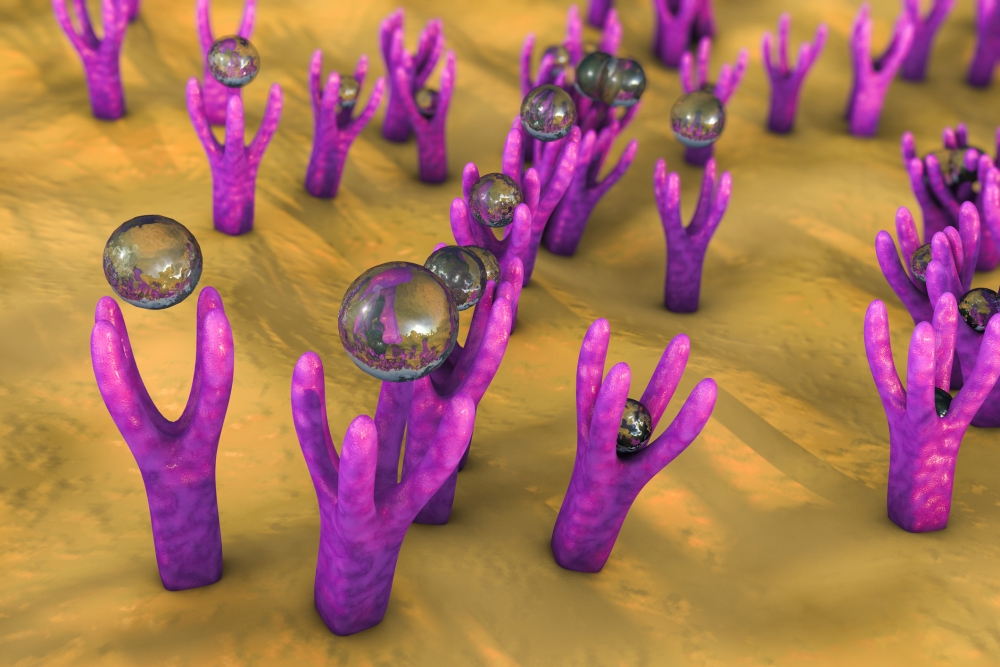
Affinity vs. Cooperativity
Our biological processes rely on a system of communications — cellular signals — that set off chain reactions in and between target cells to produce a response. The first step in these often complex communications is the moment a molecule binds to a receptor on or in a cell, prompting changes that can trigger further signals that propagate across systems. From food tasting and blood oxygenation during breathing to drug therapy, receptor binding is the fundamental mechanism that unlocks a multitude of biological functions and responses.
UC Santa Barbara researchers in chemist Kevin Plaxco’s lab are deeply interested in the mechanics of biomolecular receptors, which have great potential biotechnology applications, including the design of biosensors. In a paper in the Proceedings of the National Academy of Sciences, the researchers develop a modular design approach for tuning two important and typically opposing aspects of biomolecular receptor binding: affinity and cooperativity.
“There is a trade-off between cooperativity and affinity,” said Gabriel Ortega, lead author of the study. This type of balancing act is common in nature, he added. “If you improve one property of a system, you’re most likely making another property worse.”
And so it is with cooperativity, a property related to the ability of multibinding site receptors to respond to small changes in the concentration of their target molecule. Same goes for affinity, the concentration of the target molecule that is required for it to bind its receptor — related to the receptors’ sensitivity to the smallest concentrations of target molecule.
Nature’s Switch
“Nature wants to achieve very tight regulation of all processes that occur in the body,” Ortega explained. For that to happen, our bodies need to be able to distinguish between small changes in the concentration of target molecules, he said, and, in the case of cooperative binding, mount a more dramatic, more “all-or-none” response to changes in concentration.
“The most typical example is hemoglobin binding oxygen,” Ortega said. Carried by blood cells, these proteins have four binding sites for oxygen, which they gather as blood flows through the lungs.
The first binding event has the lowest affinity. “It acts like a gatekeeper, and it absorbs a lot of the signal,” he said, “but once you occupy that lower affinity regime, the other sites, which have a higher affinity, bind more readily.” He likens it to a system of connected pools where the first is the deepest and acts like a reservoir. Once it saturates, the rest fill up almost instantaneously.
“You want the hemoglobin to be able to completely capture the oxygen when it’s in the lungs, and then completely release the oxygen when it’s in the tissues,” Ortega said, adding that many biological processes require such a digital-like response, in which receptors shuttle between nearly fully activated or nearly completely shut down in response to small changes in a signaling cue. Signals between brain and nerve cells operate this way, as do muscle cells.
Cooperative receptors are also of interest in biological engineering. For example, they can be used to improve the precision with which biosensors measure their targets (by steepening the curve relating output to target concentration), which can be very beneficial for pharmaceutical applications where some drugs, such as chemotherapies, feature a very narrow range between ineffective and toxic.
Here’s the rub: To create that steeper, cooperative receptor, the first binding event has to have a low affinity, which means the overall affinity of the receptor site is lower than it would be if it were comprised only of its highest-affinity receptor. In areas like biosensing, this means the improved precision that comes with cooperativity is linked to an inability to detect the lowest concentrations of the target.
“If you make cooperativity better but it comes at the expense of pushing your detection capacity outside the window that you want to detect, then it’s useless,” Ortega said.
A Game of Averages
The researchers explored a way to sidestep this seesaw with a method that can increase both affinity and cooperativity in their aptamer-based biosensors, and allow biosensor designers to fine tune between cooperativity and affinity.
“If you add more high-affinity binding sites, then you’re still improving your responsiveness because you’re still improving cooperativity, but now your overall affinity is going to be closer to the highest affinity site, thus improving your sensitivity,” Ortega said.
In the Plaxco Lab, aptamers — single strands of DNA— act as their multisite receptors, changing shape as they come into contact with target molecules (In this case, the chemotherapy drug doxorubicin). Two binding sites, one with low affinity and one with high affinity, produce a cooperative response with the overall affinity being the average of the two; a third high-affinity site pushes the average affinity higher while increasing cooperativity. The result? A sensor that can detect not only low doxorubicin concentrations but also minute changes in those concentrations.
Meanwhile, added Ortega, adding another low-affinity receptor can increase cooperativity even further, albeit at the cost of reducing affinity a bit more.
“You’re always going to get progressively more cooperativity and more affinity (relative to fewer binding sites),” Ortega said. “And by playing with the affinity of each individual binding site you can tailor your system to any affinity-cooperativity combination in between.”
The researchers plan to put their design to work to improve the aptamer-based sensors that they have already developed to detect clinically relevant molecules. They are moving toward in-vitro and in-vivo studies in which they deploy these sensors to detect the presence and concentration of target molecules in real-time. In addition, Ortega plans to use these new design principles to work in much more delicate and complex protein systems.
“I think that now that we have proof that these fundamental principles work, we can try to use them in proteins,” he said.
Research in this paper was conducted also by Frederick W. Dahlquist at UCSB, and Davide Mariottini, Alessandra Troina and Francesco Ricci at the University of Rome.



